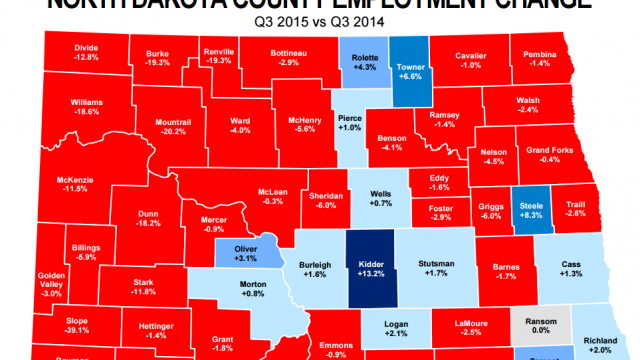North Dakota Still Has More Job Openings Than Unemployed People

Yesterday a poll of North Dakotans conducted towards the end of February showed a more than 20 shift in how citizens perceive the direction of the state, from “right track” to “wrong track.”
That’s a big shift, but it’s a shift worth putting into perspective. Even with the oil boom fading, and agriculture prices in the ditch, there were 63 percent of poll respondents who see the state on the right track.
Probably because once we drill past the negative headline, the data shows a state with a resilient economy still providing a lot of opportunities. That from a release today sent out by North Dakota Job Service’s Labor Market Research Center (see below).
There were a lot of negatives in the report, but each negative seems tempered with a positive.
[mks_pullquote align=”right” width=”300″ size=”24″ bg_color=”#ffffff” txt_color=”#000000″]”North Dakota’s rate of unemployed persons per job opening was 0.8 in December 2015, the latest month for which data are available,” the report states.[/mks_pullquote]
For instance, job openings are down. “Openings were higher by 0.5 percent (+62) from the prior month but 23.1 percent lower (-4,076) than the same month one year ago,” the report states.
But, the 13,599 job openings reported was still higher than the 9,955 active resumes recorded by Job Service.
Initial filings for unemployment benefits are way up. “North Dakota initial unemployment claims were higher by 34.4 percent (+1,471) in January 2016 compared to the same month one year ago,” the report states. “Twelve of 13 major industries reported year-over-year increases in initial claims.”
Yet, the state still has more job openings than unemployed workers. “North Dakota’s rate of unemployed persons per job opening was 0.8 in December 2015, the latest month for which data are available,” the report states. “One year prior, North Dakota’s rate was 0.6. The U.S. rate for December was 1.5.”
Total employment and wages are both down. “In Q3 2015, North Dakota’s total employment declined 3.2 percent on a year-over-year basis to 434,443, a decrease of 14,518 jobs,” the report states. “Average weekly wages were $956, lower by 2.3 percent from a year ago.”
Yet those declines aren’t quite as drastic as one might expect post-oil boom. Indeed, some of the state’s most populated areas are still seeing employment increases. As the map above shows (source), while the oil patch communities are taking a drubbing, the Bismarck/Mandan, Jamestown, and Fargo/West Fargo areas are still growing. Minot (Ward County) hasn’t been hit too badly by the oil downturn, and Grand Forks County is breaking even.
In fact, statewide the total number of employed people (the red line below) hasn’t really declined all that much from oil boom highs. We can see that the state’s labor force, or total number of people eligible for work (the blue line) has also declined which has kept the unemployment rate (the gap between the two lines) relatively static:
Recently UND economist David Flynn wrote in a SAB guest post that the state’s economic outlook isn’t quite as grim as some are letting on. He disputes the idea that North Dakota is currently in a recession. “The call of ‘recession’ is mostly coming against expectations, erroneous expectations at that,” he wrote.
Which is to say that people are comparing the current state of North Dakota’s economy to boom-time economic projections.
Big surprise, the oil boom wasn’t the new normal.
Here’s the full report.





